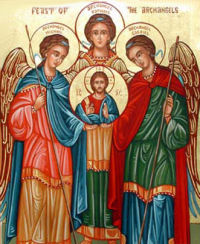Ordinary Time: September 29th
Feast of Sts. Michael, Gabriel, and Raphael, Archangels
Other Commemorations: St. John of Dukla, Religious (RM) ; Other Titles: Michaelmas; Jan of Dukla
» Enjoy our Liturgical Seasons series of e-books!
The liturgy celebrates the feast of these three archangels who are venerated in the tradition of the Church. Michael (Who is like God?) was the archangel who fought against Satan and all his evil angels, defending all the friends of God. He is the protector of all humanity from the snares of the devil. Gabriel (Strength of God) announced to Zachariah the forthcoming birth of John the Baptist, and to Mary, the birth of Jesus. His greeting to the Virgin, "Hail, full of grace," is one of the most familiar and frequent prayers of the Christian people. Raphael (Medicine of God) is the archangel who took care of Tobias on his journey.
According to the 1962 Missal of St. John XXIII the Extraordinary Form of the Roman Rite, today is the feast of St. Michael. St. Gabriel is observed on March 24 and St. Raphael on October 24.
The Catechism of the Catholic Church teaches us that, "The existence of the spiritual, non-corporeal beings that Sacred Scripture usually calls "angels" is a truth of faith. The witness of Scripture is as clear as the unanimity of Tradition" (#328).
"In her liturgy, the Church joins with the angels to adore the thrice-holy God. She invokes their assistance (in the funeral liturgy's In Paradisum deducant te angeli. . .["May the angels lead you into Paradise. . ."]). Moreover, in the "Cherubic Hymn" of the Byzantine Liturgy, she celebrates the memory of certain angels more particularly (St. Michael, St. Gabriel, St. Raphael, and the guardian angels)" (#335).
Angels are pure, created spirits. The name angel means servant or messenger of God. Angels are celestial or heavenly beings, on a higher order than human beings. Angels have no bodies and do not depend on matter for their existence or activity. They are distinct from saints, which men can become. Angels have intellect and will, and are immortal. They are a vast multitude, but each is an individual person. Archangels are one of the nine choirs of angels listed in the Bible. In ascending order, the choirs or classes are 1) Angels, 2) Archangels, 3) Principalities, 4) Powers, 5) Virtues, 6) Dominations, 7) Thrones, 8) Cherubim, and 9) Seraphim.
The previous liturgical calendar (1962) celebrated solely the feast of St. Michael on September 29. St. Gabriel was observed on March 24 and St. Raphael on October 24. This is why there are more traditions regarding "Michaelmas" instead of all three archangels.
St. Michael
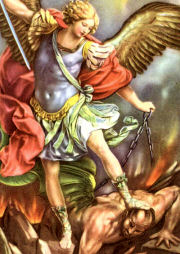 The name of the archangel Michael means, in Hebrew, who is like unto God? and he is also known as "the prince of the heavenly host." He is usually pictured as a strong warrior, dressed in armor and wearing sandals. His name appears in Scripture four times, twice in the Book of Daniel, and once each in the Epistle of St. Jude and the Book of Revelation. From Revelation we learn of the battle in heaven, with St. Michael and his angels combatting Lucifer and the other fallen angels (or devils). We invoke St. Michael to help us in our fight against Satan; to rescue souls from Satan, especially at the hour of death; to be the champion of the Jews in the Old Testament and now Christians; and to bring souls to judgment.
The name of the archangel Michael means, in Hebrew, who is like unto God? and he is also known as "the prince of the heavenly host." He is usually pictured as a strong warrior, dressed in armor and wearing sandals. His name appears in Scripture four times, twice in the Book of Daniel, and once each in the Epistle of St. Jude and the Book of Revelation. From Revelation we learn of the battle in heaven, with St. Michael and his angels combatting Lucifer and the other fallen angels (or devils). We invoke St. Michael to help us in our fight against Satan; to rescue souls from Satan, especially at the hour of death; to be the champion of the Jews in the Old Testament and now Christians; and to bring souls to judgment.
This day is referred to as "Michaelmas" in many countries and is also one of the harvest feast days. In England this is one of the "quarter days," which was marked by hiring servants, electing magistrates, and beginning of legal and university terms. This day also marks the opening of the deer and other large game hunting season. In some parts of Europe, especially Germany, Denmark, and Austria, a special wine called "Saint Michael's Love" (Michelsminne) is drunk on this day. The foods for this day vary depending on nationality. In the British Isles, for example, goose was the traditional meal for Michaelmas, eaten for prosperity, France has waffles or Gaufres and the traditional fare in Scotland used to be St. Michael's Bannock (Struan Micheil) — a large, scone-like cake. In Italy, gnocchi is the traditional fare.
Patronage: against danger at sea; against temptations; ambulance drivers; arms manufacturers; artists; bakers; bankers, banking; barrel makers, coopers; battle; cutlers, knife grinders, knife sharpers; dying people; emergency medical technicians, EMTs, paramedics; fencers; fencing; Greek Air Force; greengrocers; grocers; Guild of Tanners and Weavers of Barcelona, Spain; haberdashers; hatmakers, hatters, cap makers; holy death; knights; mariners, sailors, watermen; boatmen; milliners; paratroopers; police officers; radiologists (proclaimed on 15 January 1941 by Pope Pius XII); radiotherapists; scale makers; security guards; sick people; soldiers; Spanish police officers; storms at sea; swordsmiths. See CatholicSaints.info for a whole list.
Symbols and Representation: Angel with wings; dressed in armor; lance and shield; scales; shown weighing souls; millstone; piercing dragon or devil; banner charged with a dove; symbolic colors orange or gold
St. Gabriel
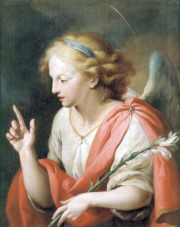 St. Gabriel's name means "God is my strength." Biblically he appears three times as a messenger. He had been sent to Daniel to explain a vision concerning the Messiah. He appeared to Zachary when he was offering incense in the Temple, to foretell the birth of his son, St. John the Baptist. St. Gabriel is most known as the angel chosen by God to be the messenger of the Annunciation, to announce to mankind the mystery of the Incarnation.
St. Gabriel's name means "God is my strength." Biblically he appears three times as a messenger. He had been sent to Daniel to explain a vision concerning the Messiah. He appeared to Zachary when he was offering incense in the Temple, to foretell the birth of his son, St. John the Baptist. St. Gabriel is most known as the angel chosen by God to be the messenger of the Annunciation, to announce to mankind the mystery of the Incarnation.
The angel's salutation to our Lady, so simple and yet so full of meaning, Hail Mary, full of grace, has become the constant and familiar prayer of all Christian people.
Patronage: Ambassadors; broadcasting; childbirth; clergy; communications; diplomats; messengers; philatelists; postal workers; public relations; radio workers; secular clergy; stamp collectors; telecommunications; Portugal; Archdiocese of Seattle, Washington
Symbols and Representation: Archangel; scepter and lily; MR or AM shield; lantern; mirror; olive branch; scroll with words Ave Maria Gratia Plena; Resurrection trumpet; shield; spear; lily; symbolic colors, silver or blue
St. Raphael
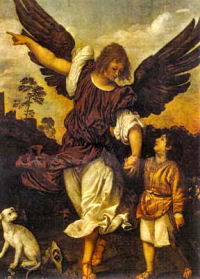 Our knowledge of the Archangel Raphael comes to us from the book of Tobit. His mission as wonderful healer and fellow traveller with the youthful Tobias has caused him to be invoked for journeys and at critical moments in life. Tradition also holds that Raphael is the angel that stirred the waters at the healing sheep pool in Bethesda. His name means "God has healed."
Our knowledge of the Archangel Raphael comes to us from the book of Tobit. His mission as wonderful healer and fellow traveller with the youthful Tobias has caused him to be invoked for journeys and at critical moments in life. Tradition also holds that Raphael is the angel that stirred the waters at the healing sheep pool in Bethesda. His name means "God has healed."
Patronage: Blind; bodily ills; counselors; druggists; eye problems; guardian angels; happy meetings; healers; health inspectors; health technicians; love; lovers; mental illness; nurses; pharmacists; physicians; shepherds; against sickness; therapists; travelers; young people; young people leaving home for the first time; Archdiocese of Dubuque, Iowa; Archdiocese of Seattle, Washington
Symbols and Representation: Staff; wallet and fish; staff and gourd; archangel; young man carrying a staff; young man carrying a fish; walking with Tobias; holding a bottle or flask; symbolic colors, gray or yellow
Highlights and Things to Do:
- This is a good feast to learn more about the angels. Children especially are fascinated by these celestial beings. The best place to start is the Catechism of the Catholic Church, nos. 328-336 to see the teachings of the Church on angels. John Paul II also did a Catechesis on the Angels during his General Audiences from July 9 to August 20, 1986.
- Find the passages in the Bible about angels, in particular the passages about Michael, Gabriel and Raphael.
- Read the section on angels in the Directory on Popular Piety and Liturgy. The document examines the doctrine and devotions of the angels. Devotion to angels is good, but also can have deviations.
- devout gratitude to God for having placed these heavenly spirits of great sanctity and dignity at the service of man;
- an attitude of devotion deriving from the knowledge of living constantly in the presence of the Holy Angels of God — serenity and confidence in facing difficult situations, since the Lord guides and protects the faithful in the way of justice through the ministry of His Holy Angels. Among the prayers to the Guardian Angels the Angele Dei is especially popular, and is often recited by families at morning and evening prayers, or at the recitation of the Angelus.
- when, as sometimes can happen, the faithful are taken by the idea that the world is subject to demiurgical struggles, or an incessant battle between good and evil spirits, or Angels and daemons, in which man is left at the mercy of superior forces and over which he is helpless; such cosmologies bear little relation to the true Gospel vision of the struggle to overcome the devil, which requires moral commitment, a fundamental option for the Gospel, humility and prayer;
- when the daily events of life, which have nothing or little to do with our progressive maturing on the journey towards Christ are read schematically or simplistically, indeed childishly, so as to ascribe all setbacks to the devil and all success to the Guardian Angels. The practice of assigning names to the Holy Angels should be discouraged, except in the cases of Gabriel, Raphael and Michael whose names are contained in Holy Scripture.
- Also read All About the Angels.
- Memorize the prayer to St. Michael the Archangel. Although no longer formally recited after Mass, Pope St. John Paul II has encouraged us to recite this prayer daily. Read about this prayer. Here is the Regina Caeli message from April 24, 1994 during which the Pope encouraged this prayer.
- In honor of St. Gabriel, Learn the Angelus and recite it daily. Traditionally, the prayer is prayed at the 6:00 and 12:00 hours (am and pm). There is a partial indulgence attached to those who pray this prayer.
- Read the Book of Tobit for the story of St. Raphael helping Tobit and Tobias.
- Find out more about the archangels:
- Catholic Encyclopedia: St. Gabriel
- Catholic Encyclopedia: St. Raphael
- Catholic Encyclopedia: St. Michael
- The Golden Legend: St. Michael
- New Liturgical Movement: St. Raphael
- New Liturgical Movement: Apparition of St. Michael
- New Liturgical Movement: Gabriel, The Messenger Angel
- Catholic Ireland
- CatholicSaints.info: St. Gabriel
- CatholicSaints.info: St. Michael
- CatholicSaints.info: St. Raphael
- Make some recipes related to Michaelmas. See the right blue sidebar for a list of suggestions. Of special mention is the St. Michael Bannock from Scotland (see also this version), roast goose and stuffing from Britain, waffles from France, and roast duck from Germany or France, gnocchi from Italy. Blackberries, apples and carrots also play a large role on this feast in various countries. Other ideas: make an angel food cake, devil's food cake or angel hair pasta. Decorate with white, symbolizing the angels, or use other symbolic colors (see above). Non-dessert items: deviled eggs, deviled meats, etc.
- Try to find the Michaelmas daisy, a purple aster, to use for decoration. It also comes in other colors, including white, but purple is the most popular. It usually blooms in late summer until October. The official name is Aster novi-belgii, but is also known as New York aster. If you find plants or seeds to plan for next year's garden. This site has photos and gardening information for the Michaelmas daisy.
- Folklore in the British Isles suggests that Michaelmas day is the last day that blackberries can be picked. It is said that when St. Michael expelled Lucifer, the devil, from heaven, he fell from the skies and landed in a prickly blackberry bush. Satan cursed the fruit, scorched them with his fiery breath, and stamped and spat on them, so that they would be unfit for eating. A traditional Irish proverb says:
On Michaelmas Day the devil puts his foot on the blackberries. - Catholic Cuisine has many unique food suggestions for this feast day.
Devotion to the Holy Angels gives rise to a certain form of the Christian life which is characterized by:
217. Popular devotion to the Holy Angels, which is legitimate and good, can, however, also give rise to possible deviations:
If you have access to blackberries, make this the last picking and eating. Perhaps make a blackberry pie? See Michaelmas Pie for a great recipe.
St. John of Dukla
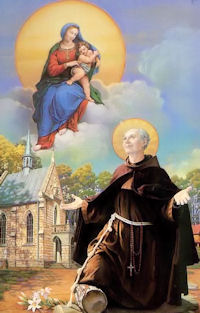 St. John (or Jan) of Dukla was a Franciscan missionary who was born in Dukla, Galicia, Poland, around 1414 and grew up a deeply religious person. He began his religious life as a hermit but then entered the Conventual Franciscans and was ordained. From 1440-1463 he labored as a preacher, and he was elected superior of the monastery because of his holiness and sound judgment. After serving his term in the monastery, John traveled as a missionary to the area of Lvov, in the Ukraine. There a group of Observant Franciscans, called the Bernardines, were conducting their ministries. John was attracted by the Bernardine spirit and transferred to that branch of the order. He was stricken with blindness in the last years of his life, but he did not retire from his pastoral duties. John preached and found his way to the confessional by groping along the pews. He died in Lvov, on September 29, 1484, a beloved priest. He was beatified in 1733 by Pope Clement XII. Pope John Paul II canonized John in Krosno, Poland, on June 10, 1997.
St. John (or Jan) of Dukla was a Franciscan missionary who was born in Dukla, Galicia, Poland, around 1414 and grew up a deeply religious person. He began his religious life as a hermit but then entered the Conventual Franciscans and was ordained. From 1440-1463 he labored as a preacher, and he was elected superior of the monastery because of his holiness and sound judgment. After serving his term in the monastery, John traveled as a missionary to the area of Lvov, in the Ukraine. There a group of Observant Franciscans, called the Bernardines, were conducting their ministries. John was attracted by the Bernardine spirit and transferred to that branch of the order. He was stricken with blindness in the last years of his life, but he did not retire from his pastoral duties. John preached and found his way to the confessional by groping along the pews. He died in Lvov, on September 29, 1484, a beloved priest. He was beatified in 1733 by Pope Clement XII. Pope John Paul II canonized John in Krosno, Poland, on June 10, 1997.
—Excerpted from Our Sunday Visitor's Encyclopedia of Saints, Matthew Bunson, Margaret Bunson, Stephen Bunson
Patronage: Poland and Lithuania
Highlights and Things To Do:
- Read more about St. John:
- You can hike to see his hermitage on the slopes of the Zaśpit Mountain in Poland.
- Read the homily for the Mass for the Canonization of Blessed John of Dukla, Homily of John Paul II.
- Read Pope St. John Paul II's address at the Visit to the Tomb of Blessed John of Dukla from June 9, 1997.


